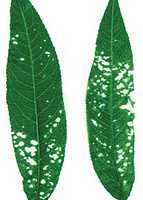Vexing Viruses In Stone Fruit

Viruses can be devastating to an orchard. But understanding how they work can be the key to averting disaster and nipping potentially big problems in the bud.
Viruses are tricky, because detecting them isn’t always easy, says Simon Scott, professor of plant pathology specializing in viruses of fruit trees and woody ornamentals at Clemson University. Viruses do not always cause visible symptoms in trees, and a latent virus can be harming a tree’s performance without the grower even realizing it is present. “Most frequently, symptoms are expressed in the growing season during which the tree becomes infected,” Scott says. “This is known as the ‘acute’ phase of infection, and the majority of pictures used for identifying viral infection represent symptoms observed during this phase.” In subsequent growing seasons, he adds, it is likely that symptoms won’t be visible. This is the chronic phase, in which the infecting virus is latent. Changes in growing conditions, however, can cause symptoms to appear. Furthermore, symptoms may not appear uniformly over the whole tree, but may be restricted to a few leaves on a single shoot (see photo at right).
The other point to consider about viruses is that there is no cure for them. “The tree will retain the virus for the rest of its life and, if the virus is transmissible by vectors, the tree can act as a reservoir of the virus to infect other trees for the remainder of its life.”
How Viruses Spread
While viruses are spread by a number of living organisms or “vectors,” there are some viruses that affect fruit trees for which no vectors have been identified, Scott notes. Viruses also can be spread through propagation. “Propagating trees using an infected tree as a source of budwood leads to 100% of the progeny being infected with the virus,” Scott says. Making sure both rootstocks and scions originate from virus-tested mother trees is key. “Although vectors may spread viruses between adjacent trees and/or orchards, major dissemination of a virus usually originates from the spread of infected material,” Scott explains.
The most surefire way to eliminate stone fruit viruses is to start new orchards in an isolated area, at least 500 meters away from existing orchards, Scott says, and to use virus-tested planting stock.
Dealing With Viruses
Scott says that if you suspect a virus has infected your orchard, your first step should be to contact Extension personnel, particularly those knowledgeable about fruit viruses, and have them inspect the trees in question. “Symptoms typically associated with infection by some fruit tree viruses can be confused with diseases of fungal and bacterial origin and also are similar to pesticide toxicity,” he says.
It’s also important to have the trees tested to detect and confirm suspected viruses before deciding what action to take. “Removing a few trees may prevent infection of adjacent trees, but if dealing with an entire orchard, the decision may be more difficult,” says Scott. For an older orchard nearing the end of its profitable life, removing it might be the best option so you can instead invest in a new orchard using the inputs that would have gone into the old one. If it’s a newer orchard? “Perhaps you will have to live with this because of the extent of investment,” Scott says. “But plant newer orchards some distance away from older orchards to try and prevent infection.”










